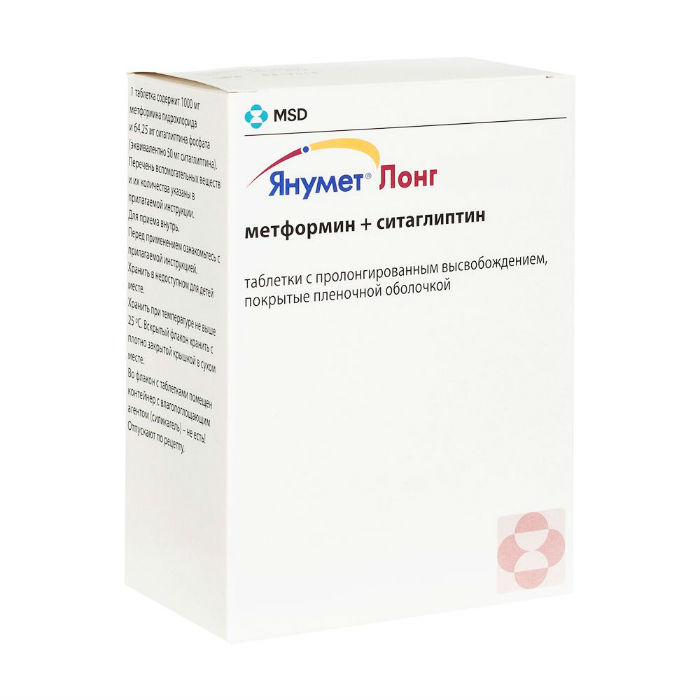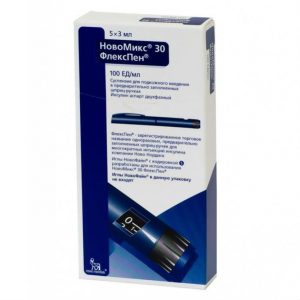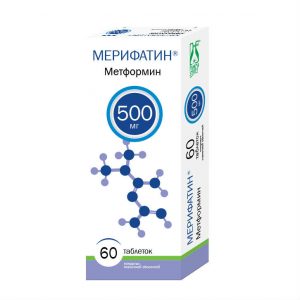Description
Pharmacological action
Yanumet Long is a combined hypoglycemic drug, the mechanism of action of which is due to the properties of two active components – metformin and sitagliptin.
Metformin belongs to the class of biguanides, It has a complementary (complementary) effect aimed at improving glycemia control in patients with type 2 diabetes. It has a prolonged release, glucose tolerance increases as a result of a decrease in basal and postprandial plasma glucose concentrations.
Unlike other classes of oral hypoglycemic drugs, the mechanism of pharmacological action of metformin is to reduce the synthesis of glucose in the liver and the absorption of glucose in the intestine. Also, metformin, by enhancing peripheral uptake and utilization of glucose, increases insulin sensitivity.
Compared with sulfonylurea derivatives, it does not cause hypoglycemia and hyperinsulinemia in patients with type 2 diabetes and in healthy people (except in special cases).
During treatment with metformin, insulin secretion does not change, while the level of fasting insulin and its daily concentration in the blood plasma can usually decrease.
Sitagliptin when taken orally is a strong, active, highly selective inhibitor of the enzyme dipeptidyl peptidase-4 (DPP-4), used to treat type 2 diabetes mellitus.
The pharmacological effects of all DPP-4 inhibitors are caused by the activation of incretins. As a result of the inhibition of the DPP-4 enzyme by sitagliptin, the concentration of such known active hormones of the incretin family as glucose-dependent insulinotropic polypeptide (HIP) and glucagon-like peptide-1 (GLP-1) increases. The incretins are part of the internal physiological system for regulating glucose homeostasis. Therefore, at normal or elevated blood glucose levels, HIP and GLP-1 potentiate the synthesis and secretion of insulin by the beta cells of the pancreas.
In addition, GLP-1 suppresses the secretion of glucagon by pancreatic alpha cells, thus reducing the synthesis of glucose in the liver (gluconeogenesis). Therapeutic concentrations of sitagliptin do not inhibit the activity of the related enzymes DPP-8 or DPP-9.
By the pharmacological action and chemical structure, sitagliptin differs from GLP-1 analogues, sulfonylurea or meglitinide derivatives, insulin, biguanides, alpha-glucosidase inhibitors, gamma receptor agonists activated by peroxisome proliferators (PPAR- ), and analogs of amylin. After oral administration of a single dose of sitagliptin in patients with type 2 diabetes mellitus, the activity of the enzyme DPP-4 is suppressed for 24 hours. During this period, there is a 2 ² 3-fold increase in the concentration of circulating active hormones GLP-1 and HIP, an increase in the level of insulin and C-peptide in blood plasma, a decrease in the concentration of glucagon, and fasting glucose. The amplitude of glucose concentration fluctuations decreases both after an oral glucose load and after a meal.
The results of phase III clinical trials in patients with type 2 diabetes mellitus, which lasted 18 and 24 weeks with the use of sitagliptin at a dose of 100 mg per day, showed a significant improvement in the function of pancreatic beta cells. This was evidenced by the corresponding changes in several markers, including the beta cell insulin resistance index (HOMA- ), Which allows us to evaluate the functional activity of pancreatic beta cells, the ratio of proinsulin and insulin, the reaction of beta cells of the pancreas according to the results of glucose tolerance test.
According to phase II clinical studies, the therapeutic effect when taking sitagliptin at a dose of 50 mg 2 times a day is comparable to the glycemic control achieved with a single dose of 100 mg.
It has been established that on the background of monotherapy with sitagliptin or metformin after eating, the weighted average value of the increasing concentration of the active hormone GLP-1 increases by about 2 times within 4 hours.
With a combination of sitagliptin and metformin, the summation of their effect contributes to an increase in the concentration of the active hormone GLP-1 by about 4 times compared with placebo. After taking sitagliptin alone due to inhibition of the DPP-4 enzyme, there is an increase in the concentration of only the active hormone GLP-1, and taking only metformin is accompanied by a symmetric increase in the concentration of the active and total hormone GLP-1.
This information indicates various mechanisms of action of active substances responsible for increasing the concentration of the active hormone GLP-1, and that it is sitagliptin that increases the concentration of the active hormone HIP. Reception of sitagliptin is not accompanied by a decrease in blood glucose concentration or the development of hypoglycemia in healthy individuals. This allows us to make the assumption that the glucagon-suppressive and insulinotropic effects of the drug are glucose-dependent.
In patients with normal blood pressure (BP), sitagliptin does not cause changes. In case of arterial hypertension, the simultaneous use of sitagliptin with such antihypertensive drugs (one or several) as diuretics, angiotensin converting enzyme inhibitors (ACEs), beta-blockers, angiotensin II receptor antagonists (ARA II), calcium channel blockers, is generally well tolerated by patients. In this category of patients, a slight hypotensive effect of sitagliptin in a daily dose of 100 mg was noted. When taking sitagliptin at the recommended dose, its effect on cardiac electrophysiology (including the QTc interval) is not observed, including at the time of its maximum concentration (Cmax) in blood plasma.
Indications
As a starting therapy in patients with type 2 diabetes mellitus to improve glycemic control when dieting and exercise regimen do not allow adequate glycemic control
to be achieved As an addition to diet and exercise regimen to improve glycemic control in patients with type 2 diabetes did not achieve adequate glycemic control during monotherapy with metformin or sitagliptin, or patients already taking a combination of sitagliptin and metformin
monotherapy in combination with sulfonylurea derivatives (triple combination therapy: metformin + sitagliptin + sulfonylurea derivative) as an adjunct to physical exercise patients with type 2 diabetes who have not achieved adequate glycemic control during therapy with any two of the three indicated drugs – meth formin, sitagliptin, or
sulfonylurea derivative In combination with PPAR- agonists (thiazolidinediones) as a supplement to the diet and exercise regimen in patients with type 2 diabetes mellitus, did not achieve adequate glycemic control during therapy with any two of the three drugs – metformin, sitagliptin, or PPAR-β agonist
In combination with insulin as a supplement to diet and exercise regimen in patients with type 2 diabetes to improve glycemic control.
Contraindications
Known hypersensitivity to sitagliptin, metformin, or any of the components of the drug Janumet Long
Kidney disease or decreased renal function (at a serum creatinine concentration of 1.5 mg / dl (in men) and 1.4 mg / dl (in women) or a decrease in Cl creatinine (<60 ml / min), including due to cardiovascular collapse (shock), acute myocardial infarction and septicemia Acute conditions with a risk of developing renal dysfunction, such like dehydration (vomiting, diarrhea), fever, more severe general infectious diseases of hypoxia (shock, sepsis, kidney infections, broncho-pulmonary diseases) application less than 48 hours before and within 48 hours after radiological studies with intravascular administration of iodine-containing contrast agents Acute or chronic metabolic acidosis, including diabetic ketoacidosis (with or without coma) Clinically expressed manifestations of acute and chronic diseases that can lead to the development of tissue hypoxia, such as heart or respiratory failure, acute myocardial infarction Hepatic failure, impaired liver function Chronic alcoholism, acute alcohol poisoning Type 1 diabetes mellitus Pregnancy Breastfeeding period Age up to 18 years (due to insufficient data on efficacy and safety). Composition 1 tablet contains: Calcium carbonate 1250 mg (corresponds to 500 mg calcium) Colecalciferol (vitamin D3) 200 IU Excipients: Sorbitol Mint flavor contains: sitagliptin phosphate 128.50 mg, which corresponds to a content of sitagliptin 100 mg metformin 1000 mg. Storage conditions In a dry place inaccessible to children, at a temperature not exceeding + 25 ° Ñ. Active ingredient Metformin, Sitagliptin Terms of delivery from pharmacies Prescription dosage form tablets




